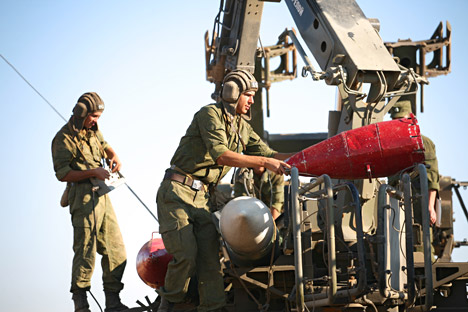Russia's Defense Ministry to get "all-seeing eye" in 2013

Russia's new multi-positional reconnaissance information system will be able to track down aircraft and ships at a distance of several thousand kilometers, experts say. Source: RIA Novosti / Kirill Braga
Russia’s Defense Ministry is in the process of completing the technical documentation and securing project financing for Russia's new multi-positional reconnaissance information system (MRIS). A source at the ministry told Izvestia that deployment was due to begin late next year.
"The system can detect and track aircraft and ships at a distance of several thousand kilometers," said the spokesperson from the Defense Ministry. "At long range, our ‘all-seeing eye’ is much more effective than current air and space radar systems."
The technical specification of the new wonder system is strictly classified, but Izvestia’s source shared some of the basic operating principles:
"All civilian and military ground and air targets have several systems that emit radio waves: radar, GPS/GLONASS trackers, radio altimeters, etc. Aircraft also emit infrared and other types of energy. Even America's stealth B-2 and F-22 cannot escape the laws of physics. The task of MRIS is to locate this radiation, give its precise coordinates, and track its movement," he said.
According to his statement, MRIS is already able to track and classify some types of radiation. The range of the "all-seeing eye" could be expanded to include control over the movement of ground-based equipment.
"Because MRIS just listens and emits no radiation itself, the enemy does not know that it has been discovered," the source said.
MRIS requires an area of a few hundred square feet beneath an antenna. According to the spokesperson from the Defense Ministry, the position of the system is almost undetectable from the air or from space.
"The first tests were conducted in 2009 on aircraft and ships belonging to the Russian navy. A positioning station outside Moscow was able to detect and track different types of aircraft over the Barents Sea. When MRIS data was matched against the actual vector of the aircraft, the deviation was found to be just a few meters," said the MoD source.
For the past few years, a similar project has been operated by British Aerospace (BAE) Systems. Its NAVSOP technology is just as secret as Russia's MRIS — development of the former only became known in August of this year. The British team formally announced in a press release that traditional technologies (i.e., GPS) are not always accurate enough. They stated that this was "evidenced by the latest incidents on the North Korean border," when South Korea's air defense system failed to spot missiles fired from the North.
NAVSOP provides an integrated solution, says BAE, and involves tracking radiation from cell towers, Wi-Fi access points, radio masts, TV antenna signals, and virtually all other sources of radio signal as well.
Whereas the British developers say that the technology will only be used in military hardware, MRIS has a dual purpose.
Director of the Institute of Strategic Studies, Alexander Konovalov, told Izvestia that Russia lacks a proper system of surveillance and information exchange.
"If MRIS is able to give a target designation to smart weapons with a high degree of reliability, it will enhance the capacity to destroy the enemy anywhere on the globe," said Konovalov. In his opinion, the "all-seeing eye" should form part of every reconnaissance and information system built in Russia, both now and in the future.
The article is abridged and first published in Russian in the Izvestia newspaper.
All rights reserved by Rossiyskaya Gazeta.
Subscribe
to our newsletter!
Get the week's best stories straight to your inbox